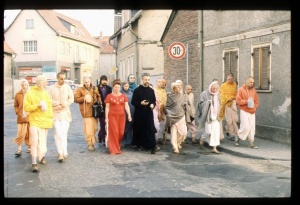CC Adi 5.58 (1975)

A.C. Bhaktivedanta Swami Prabhupada
TEXT 58
- sei ta' māyāra dui-vidha avasthiti
- jagatera upādāna 'pradhāna', prakṛti
SYNONYMS
sei—that; ta'-certainly; māyāra—of the material energy; dui-vidha—two varieties; avasthiti—existence; jagatera—of the material world; upādāna—the ingredients; pradhāna—named pradhāna; prakṛti—material nature.
TRANSLATION
Māyā has two varieties of existence. One is called pradhāna or prakṛti. It supplies the ingredients of the material world.
PURPORT
Māyā, the external energy of the Supreme Personality of Godhead, is divided into two parts. Māyā is the cause and the ingredient of the cosmic manifestation. As the cause of the cosmic manifestation she is known as māyā, and as the agent supplying the ingredients of the cosmic manifestation she is known as pradhāna. An explicit description of these divisions of external energy is given in Śrīmad-Bhāgavatam (11.24.1-4). Elsewhere in Śrīmad-Bhāgavatam (10.63.26) the ingredients and cause of the material cosmic manifestation are described as follows:
- kālo daivaṁ karma jīvaḥ svabhāvo
- dravyaṁ kṣetraṁ prāṇa ātmā vikāraḥ
- tat-saṅghāto bīja-roha-pravāhas
- tvan-māyaiṣā tan-niṣedhaṁ prapadye
"O my Lord! Time, activity, providence and nature are four parts of the causal aspect [māyā] of the external energy. The conditioned vital force, the subtle material ingredients called the dravya, and material nature (which is the field of activity where the false ego acts as the soul), as well as the eleven senses and five elements (earth, water, fire, air and ether), which are the sixteen ingredients of the body-these are the ingredient aspect of māyā. The body is generated from activity, and activity is generated from the body, just as a tree is generated from a seed that is generated from a tree. This reciprocal cause and effect is called māyā. My dear Lord, You can save me from this cycle of cause and effect. I worship Your lotus feet."
Although the living entity is primarily related to the causal portion of māyā, he is nevertheless conducted by the ingredients of māyā. Three forces work in the causal portion of māyā: knowledge, desire and activity. The material ingredients are a manifestation of māyā as pradhāna. In other words, when the three qualities of māyā are in a dormant stage, they exist as prakṛti, avyakta or pradhāna. The word avyakta, referring to the nonmanifest, is another name of pradhāna. In the avyakta stage, material nature is without varieties. Varieties are manifested by the pradhāna portion of māyā. The word pradhāna is therefore more important than avyakta or prakṛti.